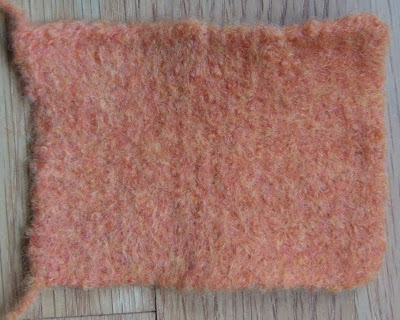After three weeks or so of playing around with felt to figure out how it works, I finally am just about done with my duck slippers. I'm still working out the bugs in the pattern, but here's a preview of the finished product.
Here they are straight out of the washing machine - my jeans are hiding the unfinished cuffs. Those strings are the ends of the cotton yarn I used to preserve the holes along the edge, for picking up stitches later (thank you Helen and Tracy for this excellent suggestion!!)

One finished cuff, on & off the foot

The next post will have the complete pattern and detailed photos of the process.
(added 5/19)
For those who don’t mind working without a lot of direction, here are the bare bones.
For slippers: 2 skeins Cascade 220 yarn, color #7827, US #8 needles.
For cuffs: 1 skein Cascade 220 Superwash, color #877, US #3 needles.
You will also need:
- crochet hook close in size to US #3 needles.
- length of cotton or other yarn that will not felt
Cast on and Round 1 same as Duck Socks. 6 sts.
Next round, Turkish cast on 2 sts (1 wrap around both needles) at each end. 10 sts
Repeat this round once. 14 sts.
TCO 4 sts (2 wraps) at each end. 22 sts.
TCO 6 sts (3 wraps) at each end. 34 sts.
TCO 10 sts (5 wraps) at each end. 54 sts.
TCO 16 sts (8 wraps) at each end. 86 sts.
Work 1 round in pattern. still 86 sts.
Place YO at each end (start with YO, work 1/2 of the round, then YO again). 88 sts.
Work 1 round in pattern. still 88 sts.
Decrease (2 top + 2 bottom) every 5th row 6 times. 64 sts.
Decrease (2 top + 2 bottom) every 4th row 2 times. 56 sts.
Change from working in the round to working back and forth. From here out, decrease on bottom only.
Decrease (2 bottom) every 4th row another 3 times. 50 sts.
Decrease (2 bottom) every 3rd row 5 times. 40 sts.
Decrease (2 bottom) every other row 5 times. 30 sts.
S2KP 3 central sts on bottom. 28 sts.
Work toes and heel as you would for booby socks (i.e., center toe does not wrap around bottom).
Pick up and knit a row of sts along the edge of opening with cotton yarn. On the second row, bind off. The bindoff does not need to be stretchy.
Felt.
After felt is done and dry, rip out cotton yarn along edge and pick up sts with superwash yarn, using crochet hook. Knit cuff as desired and bind off. I picked up a total of 92 sts, and reduced to 60 over 8 rows.






